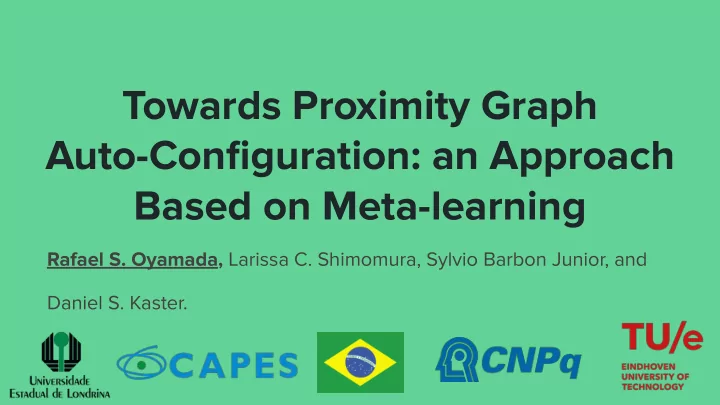

Towards Proximity Graph Auto-Configuration: an Approach Based on Meta-learning Rafael S. Oyamada, Larissa C. Shimomura, Sylvio Barbon Junior, and Daniel S. Kaster.
Summary ● Introduction and Concepts ○ Similarity Searches ○ Proximity Graphs ○ Meta-learning ● Contribution ● Experimental results ● Conclusion
Busca por similaridade Retrieving complex data (image, video, audio, etc) through its similarities.
Distance functions ● Distance functions to measure the similarity between a pair of feature vectors. ● Lp norms: Manhattan (L1), Euclidean (L2)
Similarity Queries Range query k-NN query (k=3)
Index structures for similarity searching ● Tree-based methods; ● Hash-based methods; ● Permutation-based methods; ● Graph-based methods.
Proximity Graphs ● A proximity graph is a graph G=(V, E), in which each pair of vertices (u, v) ∈ V is connected by an edge e=(u, v) iff u and v satisfy a given property P ;
Proximity Graphs ● Popular approaches are based on k-NN graphs or navigable small-world graphs ( NSW ); ● Sensible to construction and search parameters.
Parameters of major impact ● Construction: number of nearest neighbors (NN) ● Query: number of restarts (R) ○ Regarding the GNNS algorithm Usually chosen through grid search steps
Example: impact of parameters ● Choosing the best graph type and its configuration for a given dataset for achieving a minimum recall rate (0.95) ● Considering different optimization criteria ○ Memory usage, or ○ Query time
R (left) and Query Time (right) varying NN Smallest number of restarts (left) for each graph that reached recall 0.95 and its respectives query times (right). “No winner”.
Contribution An intelligent system, based on meta-learning techniques, capable of recommending a suitable proximity graph, together with its settings for a given dataset.
Meta-learning ● “Learning accross experiences”; ○ Gathering knowledge from several problems to learn how to provide suitable solutions in future. ● Algorithm selection, parameter recommendation, performance prediction, and etc; ○ Popular in machine learning community.
Proposal
Experiments
Datasets
Experimental setup ● C++ NMSLib for performance measurements Brute Force k-NNG, NNDescent, and NSW ○ ● k-NN queries using the Euclidean distance ● One meta-model for each performance measurement (recall and query time) ● Random Forests for meta-model induction Scikit-learn default parameters ○
Tuning strategies: generic (no tuning) Generic meta-model
Tuning strategies: add grid search Tuned meta-model: Grid Search
Tuning strategies: add grid search on subsets Tuned meta-model: Subsets
Accuracy evaluation: r-squared and RMSE
Recommendations ● Optimal: best graph configuration achieved from all results ● Grid search: best graph configuration achieved from a reduced parameter space ○ NN = {1, 25, 70, 150} ○ R = {1, 10, 40, 120}
Recommendation according to different criteria
Predictions per interval
Conclusion and future works ● Overall, our approaches overcome the grid search method ● The TMM-S is able to reach optimal results in most cases ● Explore more dataset descriptors ● Increase the meta-dataset with more image datasets
Thank you! Contact: rseidi.oyamada@uel.br
Recommend
More recommend